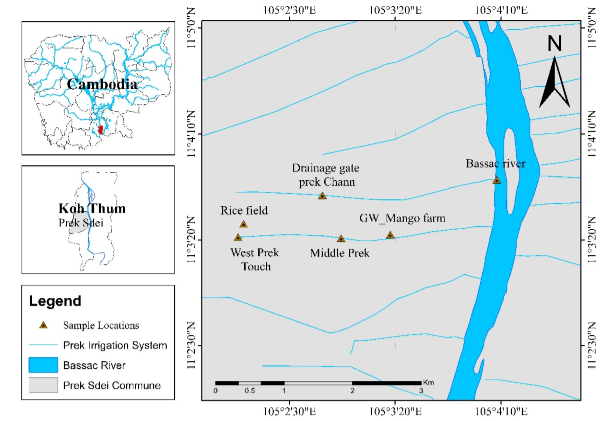Detection of Pesticide Residues in The Canal Irrigation System of The Upper Mekong Delta, Cambodia
DOI:
https://doi.org/10.51264/inajl.v3i1.24Keywords:
Pesticide detection in water, Solid phase extraction (SPE), Gas chromatography-Mass spectrometry (GC-MS), Cambodian upper Mekong delta, CambodiaAbstract
Pesticide refers to all chemical compounds which are mainly used in agriculture to control pests and weeds. In many developing countries, the increasing use of pesticides is due to agricultural activities for intensification purposes. The potential consequences for the environment, health and biodiversity are difficult to anticipate, as the presence of pesticides is difficult and rarely monitored. This is the case in the upper Mekong delta in Cambodia where many irrigation systems are being developed. The aim of the study is to provide a preliminary assessment of the situation by looking for the presence of pesticides in the water within a representative irrigation system. Water samples were collected in canals, river, irrigated rice field and groundwater in both dry and wet seasons. Solid-phase extraction (SPE) and gas chromatography-mass spectrometry (GC-MS) methods were used to purify and analyze the samples. Among 37 pesticides used by farmers and detectable, 6 were found in water. Paclobutrazol and propiconazole are moderately hazardous, hexaconazole is slightly hazardous, fluquinconazole presents acute toxicity and azoxystrobin is unlikely to present acute hazard. Hexaconazole and paclobutrazol are classified as highly persistent in water, while others are slightly to moderately persistent. Pesticides were found mostly in groundwater but they were found in the canals and rice field only in dry season. This means that pesticides may accumulate in the aquifer while the flooding has a flushing effect on pesticides. Further analyses should be extended to a bigger scale and be continued monitoring.
References
Alavanja MCR. 2009. Introduction: Pesticides use and exposure extensive worldwide. Reviews on Environmental Health, 24(4), 303–309.
Asian Development Bank (ADB). 2021. Cambodia agriculture Natural resources, and rural development sector assessment, stategy, and road map. http://dx.doi.org/10.22617/TCS210256-2
Darko G, Akoto O, Oppong C. 2008. Persistent organochlorine pesticide residues in fish, sediments and water from Lake Bosomtwi, Ghana. Chemosphere, 72, 21–24.
Deknock A, De Troyer N, Houbraken M, Dominguez-Granda L, Nolivos I, Van Echelpoel W, Forio MAE, Spanoghe P and Goethals P. 2019. Distribution of agricultural pesticides in the freshwater environment of the Guayas river basin (Ecuador). Science of the Total Environment, 646, 996–1008.
Duong HV, Nguyen TC, Nguyen XT, Nguyen MQ, Nguyen PH, and Vo TT. 2022. Evaluating the Presence of Pesticide Residues in Organic Rice Production in An Giang Province, Vietnam. Journal of Sustainable Development, 15(1), 49-64.
Fao and Iwmi. 2017. Water pollution from agriculture: a global review Executive summary. FAO and IWMI, 35. http://www.fao.org/3/a-i7754e.pdf
Frick M. 2020. Pesticide Distribution in the Hydrological Compartments in Koh Thum District, Kandal Province, during Dry Season [Master's thesis, Institute of Technology of Cambodia].
Jin X, Liu Y, Qiao X, Guo R, Liu C, Wang X, and Zhao X. 2019. Risk assessment of organochlorine pesticides in drinking water source of the Yangtze River. Ecotoxicology and Environmental Safety, 182, 109390.
Kafilzadeh F. 2015. Assessment of Organochlorine Pesticide Residues in Water, Sediments and Fish from Lake Tashk, Iran. Achievements in the Life Sciences, 9(2), 107–111.
Kaur R, Mavi GK, Raghav S, and Khan I. 2019. Pesticides Classification and its Impact on Environment. International Journal of Current Microbiology and Applied Sciences, 8(03), 1889–1897.
Liu J, Qi S, Yao J, Yang D, Xing X, Liu H, and Qu C. 2016. Contamination characteristics of organochlorine pesticides in multimatrix sampling of the Hanjiang River Basin, southeast China. Chemosphere, 163, 35–43.
Matsukawa M, Ito K, Kawakita K, and Tanaka T. 2016. Current status of pesticide use among rice farmers in Cambodia. Applied Entomology and Zoology, 51(4), 571–579.
Ministry of Environment Cambodia. 2004. National Profile on Chemicals Management in Cambodia. December 2004, 162.
Özkara A, Akyil D, and Konuk M. 2016. Pesticides, Environmental Pollution, and Health. Environmental Health Risk - Hazardous Factors to Living Species, June, 2–28.
Pratx O. 2017. Etude du fonctionnement hydro-agricole de canaux d’irrigation: Cas des «?preks?» sur les rives du Bassac au Cambodge. ENGEES, Institut de Recherche pour le Développement - UMR G-EAU.
Preap V. and Sareth K. 2015. Current use of pesticides in the agricultura; products of Cambodia. Submitted for the FFTC-KU International Workshop on Risk Management on Agrochemicals through Novel Technologies for Food Safety in Asia, November 10-14, 1, 1–9.
Sharma A, Kumar V, Shahzad B, Tanveer M, Sidhu GPS, Handa N, Kohli SK, Yadav P, Bali A S, Parihar RD, Dar OI, Singh K, Jasrotia S, Bakshi P, Ramakrishnan M, Kumar S, Bhardwaj R, and Thukral AK. 2019. Worldwide pesticide usage and its impacts on ecosystem. SN Applied Sciences, 1(11), 1–16.
Silva V, Mol HGJ, Zomer P, Tienstra M, Ritsema CJ Geissen, V. 2019. Pesticide residues in European agricultural soils – A hidden reality unfolded. Science of the Total Environment, 653, 1532–1545.
Vandome P. 2020. Agricultural vulnerability to hydrologic hazards in the prek area of the upper Mekong Delta, Cambodia. L'institut Agro, Institut de Recherche pour le Développement - UMR G-EAU.
WHO. 2008. Pesticides: Children’s Health and the Environment. World Health Organization, 1–62. http://www.who.int/ceh/capacity/Pesticides.pdf
World Health Organisation (WHO). 2019. The WHO Recommended Clasification of Pesticides by Hazard and Guideline to Classification. In World Health Organization.

Downloads
Published
Issue
Section
License
Copyright (c) 2022 Indonesian Journal of Limnology

This work is licensed under a Creative Commons Attribution 4.0 International License.






